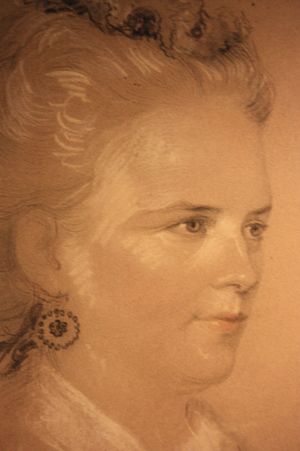Amelia Robertson Hill facts for kids
Quick facts for kids
Amelia Robertson Hill
|
|
|---|---|

Sketch by Alexander Blaikley 1853, SNPG
|
|
| Born |
Emmilla McDermaid Paton
15 January 1821 Dunfermline, Scotland
|
| Died | 5 July 1904 (aged 83) Edinburgh, Scotland
|
| Resting place | Dean Cemetery |
| Occupation | Artist and sculptor |
| Spouse(s) | David Octavius Hill |
| Relatives | Joseph Noel Paton (brother), Waller Hugh Paton (brother), Diarmid Noel Paton (nephew) |
Amelia Robertson Hill (born January 15, 1821 – died July 5, 1904) was a famous Scottish artist and sculptor. She lived and worked in the 1800s. Amelia was one of the few women artists at that time to get important public jobs.
Her most well-known artworks include the statue of David Livingstone in Princes Street Gardens, Edinburgh. She also created the statue of Scottish poet Robert Burns in Dumfries. Amelia was a major contributor to the statues on the Scott Monument. She made three figures for this famous Edinburgh landmark.
Contents
Amelia's Life Story
Amelia Hill was born in Dunfermline, Scotland. Her birth name was Emmilla McDermaid Paton. Her father, Joseph Neil Paton, designed patterns for fabric. Her mother was Catherine McDiarmid.
Amelia had two brothers, Joseph Noel Paton and Waller Hugh Paton. Both of them also became artists. Amelia likely learned how to sculpt from William Brodie in Edinburgh.
Marriage and Home
In 1862, Amelia married David Octavius Hill. He was a very important early photographer. Amelia was his second wife. They lived in Edinburgh. David was the secretary of the Royal Scottish Academy. This was an important art organization.
They moved homes a few times in Edinburgh. In 1868, they settled at Rock House near Calton Hill. They only lived there for two years. David died in 1870. After his death, Amelia moved to Newington Lodge. She made a bronze sculpture of David's face for his grave.
Later Years and Legacy
In 1891, official records said Amelia was a "sculptor, retired." But she kept showing her art until 1902. She was 82 years old then!
Amelia died at her home in Edinburgh on July 5, 1904. She was 83. She was buried next to her husband in Dean Cemetery. Her own sculpture of David was already on his grave.
Celebrating Her Work
In 2021, a special walking tour was started in Edinburgh. It was called 'The Amelia Tour'. This tour celebrated 200 years since her birth. It showed people her sculptures around the city.
Famous Sculptures and Artworks
Amelia Robertson Hill created many important sculptures. Here are some of her most famous works:
-
A sculpture of her husband, David Octavius Hill, on their grave.
-
A sculpture of Scottish painter Sir George Harvey.
-
A sculpture of the famous poet Percy Bysshe Shelley.
-
The large statue of explorer David Livingstone in Princes Street Gardens.
- Sculpture of John Fergus MP (1861): This was made for Kirkcaldy Town Hall.
- Sculpture of Mary Louise, Countess of Elgin (1863): This marble sculpture is in the Lord Elgin Hotel in Ottawa.
- Sculpture of Rev. Robert Smith Candlish (1864 and 1865): He was a leader in the Scottish church.
- Sculpture of Thomas Carlyle (1866): A famous Scottish writer.
- Sculpture of David Livingstone (1866): A smaller version of the famous explorer.
- Sculpture of her husband, David Octavius Hill (1867): Another artwork of her husband.
- Three figures for the Scott Monument (1870): These are on the huge monument to Sir Walter Scott in Edinburgh. The figures are Magnus Troil, Minna Troil, and Richard the Lionheart.
- Statue of David Livingstone (1875): This very large statue is on Princes Street in Edinburgh. People paid money to have it built.
- Memorial to Regent Murray (1876): This marks the spot where he was killed in Linlithgow.
- Figures of "Painting" and "Poetry" (1877): These sculptures are on the Albert Buildings in Edinburgh.
- Statue of Robert Burns (1881): This statue of Scotland's national poet is in Dumfries.
- Sculpture of Percy Bysshe Shelley (1882): Another sculpture of the poet.







